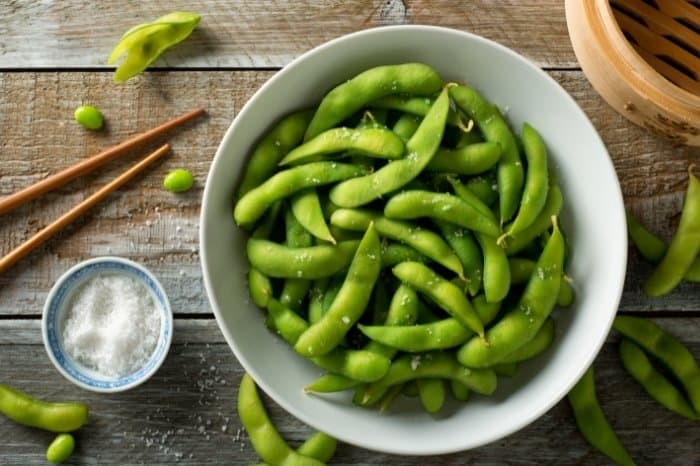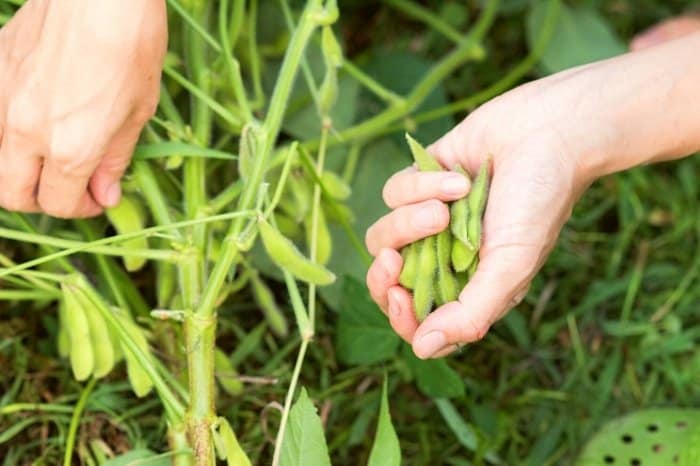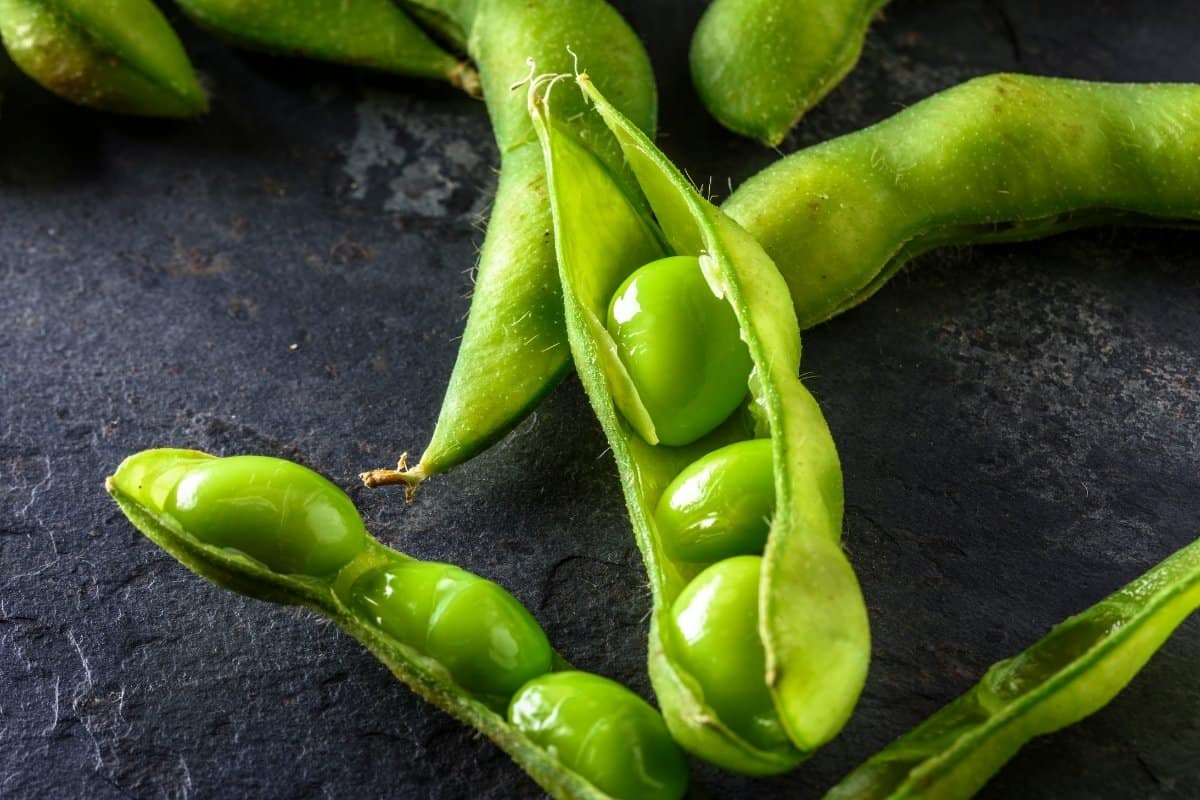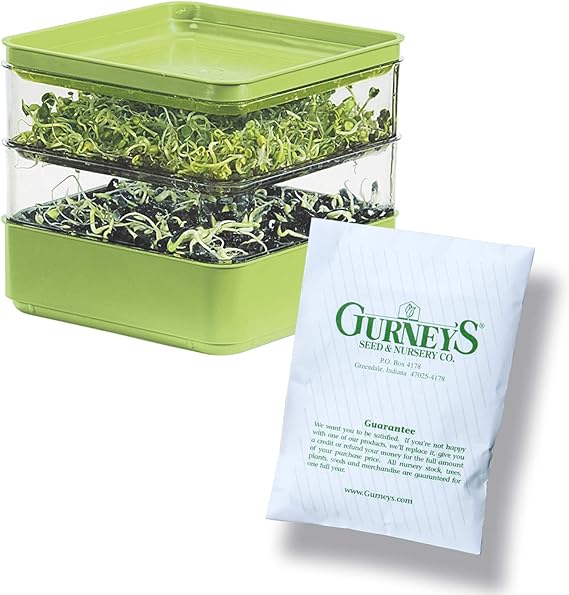Last Updated on January 30, 2022 by
In this article, we will look at how to grow edamame starting with planting as well as when to harvest edamame and how to enjoy them. Follow us along!
Edamame is originally from East Asia. It is relatively new to North American gardeners. Most gardeners lack the knowledge of growing edamame thus reducing the number of farmers growing them.
So What Exactly Is Edamame?
Simply defined, Edamame is soybeans. It is the name given to immature soybean pod.
Mature edamame pods are hard, and dry, and used to make soy milk and tofu. These two products are loved and adored by people across the world.
Edamame, because its immature soybean, is usually steamed in water before eating. It is eaten by squeezing the beans out of their pods and popping them directly into the mouth.

Sometimes these beans are referred to as either edamame beans or edamame peas. They have become iconic ingredients associated with healthy, flavorful, and much-loved Asian dishes. In Japan, Edamame has a more specific meaning. It refers to dishes made from the young soybeans enclosed in their pods.
Soy is a term used in Japanese cooking in many shapes and forms. From soy sauce to tofu, that’s why even today, edamame mostly refers to cooked soybean pods.
When To Harvest Edamame
Soybean grows within 90 and 150 days from seed to pod. Edamame is ready for harvest when the pods turn bright green and are full of plump seeds.
The pods must be at least 2 – 3-inches long. This is between 70 – 110 days. Edamame is harvested in its immature state because that’s how they are enjoyed.
You have a small window of time to pick edamame almost about five days before the seeds begin to develop a bitter flavor and a fibrous, stringy consistency that makes them inedible.
Yellowing on the pods is a sign that indicates you’ve left the pods on the plants too long and you should leave them to mature.
A Simple Guide To Edamame Growing
You can grow edamame from a seed sold as soybeans. It is essential to pick the right variety of soybeans. Different beans are for different uses; some are for making tofu or for flour, and the black soybeans are better for drying. For edamame, choose the green soybean varieties.
-
Edamame grows fast and takes 70 to 90 days from seeds before they’re ready to be harvested.
-
They are very sensitive to frost and need proper timing if you are growing them outdoors. We recommend you sprout them indoors to give you a head start before transplanting them outside in late spring.
-
Germinating edamame seeds. To save you precious time when growing edamame, germinate the seeds indoors. This method will give you control over the temperature and soil moisture. Edamame needs at least 70°F to germinate, and plenty of light. Too much water causes the bean to rot before it gets a chance to sprout a seedling.
-
Planting. You can plant either in your pots or in the garden.
-
For pots, check the number of seeds you have in the packet and prepare a germination pot for each one. You can also use compostable seedling pots that make transplanting easy without damaging the roots. Choose a pot that is 2 inches tall and fill it with compost. Place the seed in the middle and cover it with a layer of soil at least a finger deep. Avoid sowing cracked or scarred edamame seeds, as they will not germinate.
Gardens Alive! Two-Tiered Seed Sprouter with Seeds Kit
-
For the garden. Prepare your soil by loosening it. Edamame plant thrives in rich, loamy soils, with a pH of 6.0 to 7.0. Do not plant in clay or heavy soils, as this will affect the growth of your plants and stunt them or even cause root rot if the water doesn’t drain properly. If your soil is not well-draining, use soil amendments like peat moss or bark to improve its drainage.
-
Watering. Provide your planted edamame with enough water once planted. For proper watering, use a spray bottle to mist the pots daily, ensuring that the soil is moist but not soggy. For gardens avoid using a hosepipe, rather use drip irrigation.
The Right Time To Transplant
When you start your seeds indoors, you will need to transplant them at the right time. Edamame seeds take 7 days or more to sprout. These seeds are similar to peas or beans seedlings and produce large, heart-shaped leaves from the time they are small. Once you have at least 4 leaves per seedling, you can start planning to transplant them to your garden.
How To Harvest Edamame
-
Edamame has a short window period in which the beans are sweet. If they go past a few days, they become inedible and too tough.
-
Pick these beans when the pods are full.
-
Examine pods on different edamame plants starting at 75 days after planting. Look for a bright green color on the pods, like the one for snow pea pods. As soon as you notice them, start harvesting immediately. If some of the pods have started yellowing, do not harvest them rather leave them to mature as soybeans.
-
Harvest them as you would sugar snap peas or green beans. Hold them by the stem with one hand and snap them off the pods with the other hand. Do not pull the pods with one hand without supporting it because you will end up ripping off a branch of the plant or even uprooting it.

How Does Edamame Beans Taste Like?
Edamame beans taste sweet and mildly nutty. They are quite similar to beans, but when compared to peas they have a firmer consistency.
You must cook these beans before eating. Eating them raw can cause digestive problems. This applies to both edamame served in their pods, as well as the shelled and frozen versions you can find in stores.
Click here to know more about:
FAQs
How do you know when edamame is ready to pick?
The first sign that edamame is ready to be picked from the pod is when it begins to wilt. If you still see some green color on the beans, they are not done yet. Once they start to wilt, they can be eaten immediately. If you want to cook them for later, they should be drained and cooled in a strainer.
What is the growing season for edamame?
Edamame (or soybeans) are an excellent source of protein and fiber. They are high in protein, low in fat, cholesterol-free and contain significant amounts of vitamin C. Edamame are best eaten when fully ripe, but they can be harvested at various stages during their growing season. Edamame are a traditional Japanese crop that is usually grown in the late spring and early summer.
Is it okay to eat raw edamame?
You are supposed to boil them before eating. Edamame is a popular Japanese food made from soybeans. It is typically boiled and served as a side dish or snack. In Japan, it is typically eaten with rice. Edamame is a great source of protein and fiber.
Can I grow edamame in my garden?
Growing edamame in your garden is a great way to add extra protein to your diet. The edamame is a legume that grows in pods and has a lot of vitamins and nutrients, including iron, calcium, zinc, phosphorus and vitamin B.
They are easy to grow, and if you keep them picked regularly, the pods will keep fresh for up to two weeks.
What is the difference between soybeans and edamame?
The main difference is that soybeans are used to make tofu and tempeh, whereas edamame (soybean pods) are eaten boiled.
The second thing you can do with soybeans is make your own miso, which is a fermented bean paste. Miso is usually made from soybeans, but it can also be made from other legumes, such as chickpeas, mung beans, or adzuki beans.
There are a variety of ways to make miso, but most begin by soaking the soybeans in water for about 24 hours, then boiling them for about 10 minutes, then adding the rest of the ingredients and fermenting them for anywhere from 1 week to a month. Soy sauce is another fermented product made from soybeans.
How do you store harvested edamame?
I just keep them in the freezer until I'm ready to eat them and then pop them in the microwave to heat them up. They don't have a good shelf life at room temperature if you freeze them.
Are frozen edamame precooked?
No they aren't. The package says they are fresh and raw. You may have gotten some of them that way, but they would still be frozen and thawed so they will be cooked.
Is edamame high in iron?
The answer is yes, but there are a few caveats. Edamame is the Japanese name for soybeans and has the flavor of a green bean. It is eaten like an asparagus with a dipping sauce or used to make a stir-fry.
Conclusion
FAQs
How do you know when edamame is ready to pick?
The first sign that edamame is ready to be picked from the pod is when it begins to wilt. If you still see some green color on the beans, they are not done yet. Once they start to wilt, they can be eaten immediately. If you want to cook them for later, they should be drained and cooled in a strainer.
What is the growing season for edamame?
Edamame (or soybeans) are an excellent source of protein and fiber. They are high in protein, low in fat, cholesterol-free and contain significant amounts of vitamin C. Edamame are best eaten when fully ripe, but they can be harvested at various stages during their growing season. Edamame are a traditional Japanese crop that is usually grown in the late spring and early summer.
Is it okay to eat raw edamame?
You are supposed to boil them before eating. Edamame is a popular Japanese food made from soybeans. It is typically boiled and served as a side dish or snack. In Japan, it is typically eaten with rice. Edamame is a great source of protein and fiber.
Can I grow edamame in my garden?
Growing edamame in your garden is a great way to add extra protein to your diet. The edamame is a legume that grows in pods and has a lot of vitamins and nutrients, including iron, calcium, zinc, phosphorus and vitamin B.
They are easy to grow, and if you keep them picked regularly, the pods will keep fresh for up to two weeks.
What is the difference between soybeans and edamame?
The main difference is that soybeans are used to make tofu and tempeh, whereas edamame (soybean pods) are eaten boiled.
The second thing you can do with soybeans is make your own miso, which is a fermented bean paste. Miso is usually made from soybeans, but it can also be made from other legumes, such as chickpeas, mung beans, or adzuki beans.
There are a variety of ways to make miso, but most begin by soaking the soybeans in water for about 24 hours, then boiling them for about 10 minutes, then adding the rest of the ingredients and fermenting them for anywhere from 1 week to a month. Soy sauce is another fermented product made from soybeans.
How do you store harvested edamame?
I just keep them in the freezer until I'm ready to eat them and then pop them in the microwave to heat them up. They don't have a good shelf life at room temperature if you freeze them.
Are frozen edamame precooked?
No they aren't. The package says they are fresh and raw. You may have gotten some of them that way, but they would still be frozen and thawed so they will be cooked.
Is edamame high in iron?
The answer is yes, but there are a few caveats. Edamame is the Japanese name for soybeans and has the flavor of a green bean. It is eaten like an asparagus with a dipping sauce or used to make a stir-fry.
Edamame beans are not only delicious but also healthy. They are easy to grow at home and an authentic ingredient for Asian dishes.
These beans taste great when cooked the traditional Japanese way. Simply boil or steam with the pods on for 5 minutes. Sprinkle salt and serve. Pop the beans in your mouth as you eat and discard the shells.
You can also remove the shell and add them t dishes like rice, soups, salads, stir-fries, etc.
Caroline is a gardener who loves to get down to the nitty–gritty of gardening. She proudly proclaims herself as a ‘dirt worshipper‘ and can often be found deep in the garden, covered in soil and singing to her plants. As a self–proclaimed ‘plant whisperer‘, Caroline believes that plants need love and attention just like any other living thing, and she loves to give them both. When she‘s not tending to her garden, you can often find her researching the latest gardening trends, or teaching others how to make their gardens thrive


